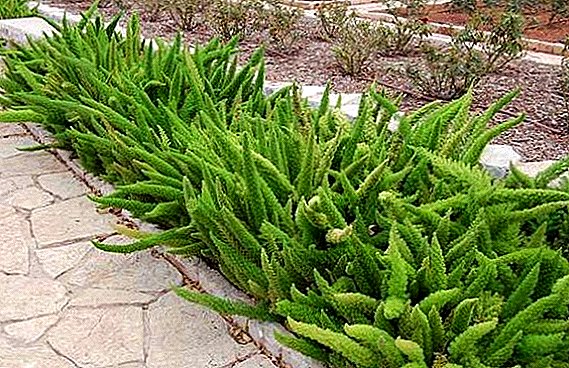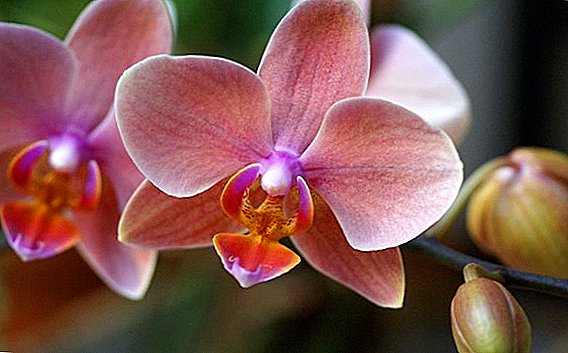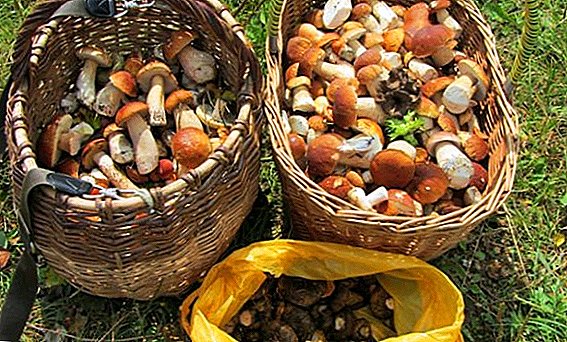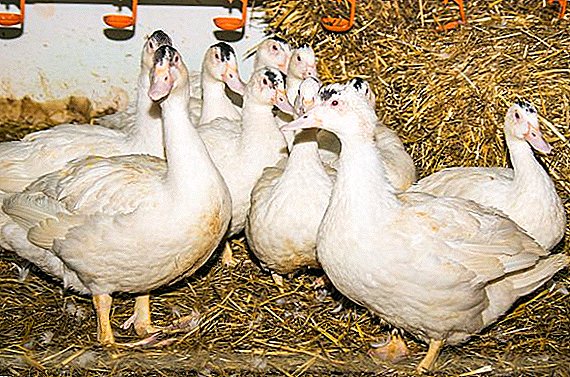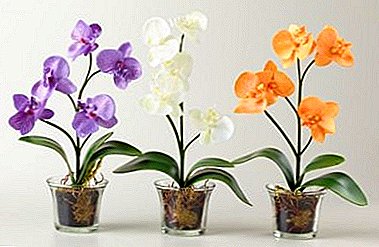
Orchid - one of the most beautiful flowers. It is not surprising that by buying this plant once, you can “get sick” with them: try to constantly pay attention to all his needs and whims, try to prolong his life by transplanting. The question of choosing a new capacity is not so simple, since there are a large number of different options. This article is an attempt to clarify the situation and get answers to many questions of interest, for example, why the orchid is most often planted in transparent containers, can it be placed in unpowered, and much more.
Is it possible to plant a plant in translucent containers, is it necessary?
Virtually the entire root system of epiphytes is in open space. Such conditions cannot be provided to the plant in apartments with central heating, a variety of appliances and household appliances. The roots wither and die. The only way out is to place the plant in a pot that will provide an isolated space for the root system.
Many sources claim that the best option in choosing a pot for transplanting is a transparent container. But is it necessary to plant an orchid in a transparent pot or not? Experienced flower growers claim that it is needed more by the owner of the orchid than by herself, and that it is not at all necessary to acquire a transparent container for the naughty beauty.
Features
A transparent pot is a container for growing plants (in this case, orchids) made from materials that transmit light: plastic, polyethylene and glass.
Advantages and disadvantages
The capacity of a transparent material has several advantages.:
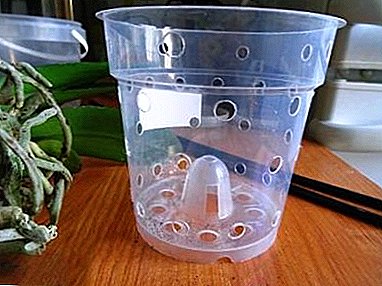 For what purpose the transparent walls of the pot are useful, so it is for tracking the condition of the roots of the orchid and the substrate. This allows you to regulate the watering of the plant, detect the diseases of the root system in time or detect pests.
For what purpose the transparent walls of the pot are useful, so it is for tracking the condition of the roots of the orchid and the substrate. This allows you to regulate the watering of the plant, detect the diseases of the root system in time or detect pests.- Plastic - a substance in which there is no pore, so the roots of an orchid will not be able to "grow" to the walls.
- Plastic maintains the optimum temperature required for the root system of the flower, that is, it does not allow its overheating and overcooling.
- Such pots better than others maintain the required level of humidity.
- If you have difficulty with the separation of the soil from the roots during transplantation, then you can cut a similar pot with ordinary stationery scissors.
- Not beating when falling.
- This type of tanks is a budget option.
There are certain disadvantages:
- Fans of everything environmentally friendly will actively oppose the use of plastic - a substance of synthetic nature, which does not have the best images on the human body and the state of the environment.
- The material from which the transparent containers are made is light enough: there will always be a risk that the plants planted in them will roll over.
- In the case of such a situation, the absence of hygroscopicity in the substance can play a bad joke: the orchid will easily fall out along with the substrate.
- Plastic pots are airtight.
- Plastic may react unpredictably to any fertilizer applied to the substrate;
- Not quite aesthetically appealing design.
The first three minuses are easy to eliminate: it is enough to “weight” the pot with a drainage layer (expanded clay, pumice stone can be used), and to ensure access of the air flow to the roots and outflow of water from the substrate, holes should be made in the bottom and walls of the vessel (for this purpose a hot nail or spoke).
Effect on various plant species
 Before planting a flower in a transparent pot, it is necessary to take into account the specific requirements for the growing conditions of various species of this plant. The root system of Phalaenopsis and Oncidium is involved in the process of photosynthesis, for which light is simply necessary. It is advisable to grow these types of orchids in containers that transmit light.
Before planting a flower in a transparent pot, it is necessary to take into account the specific requirements for the growing conditions of various species of this plant. The root system of Phalaenopsis and Oncidium is involved in the process of photosynthesis, for which light is simply necessary. It is advisable to grow these types of orchids in containers that transmit light.
Glass packaging is suitable for orchids Vand with its cultivation features, which will provide light transmission, and it will be convenient for constant movements of this flower for the purpose of watering and drying the roots. But capricious Kattlee and other hybrid orchids with pseudobulbs recommended glazed ceramics, however, like all terrestrial species (Venerin slipper).
What material to choose from?
It all depends on the orchid variety, the level of experience of the grower. Glass vessels are aesthetically attractive, but it is better for experienced lovers to grow orchids in them, because the surface watering process will require certain skills.
We offer you to get acquainted with a vivid and informative video review of orchid pots:
Suppose or not an opaque option?
If we talk about sustainability, it is preferable pots made from natural materials (clay, ceramics). But The best option for novice florists is a plastic transparent containerbecause the light transmission allows you to visually monitor the state of the roots and the substrate.
An experienced florist, who has studied all the features of each orchid variety, who knows all their "habits", does not need visualization. He can pay attention to the ceramic and clay opaque vessels.
What will help unzaton packaging know?
Transparent material from which the container is made, allows you to monitor the development of the root system, the state of the substrate, the outflow of moisture. So the color of orchid roots is one of the main indicators of its condition and health. The plant does not need watering when its roots are saturated green. If they gradually become silver-greenish, then the flower "wants to drink."
 In the case of the acquisition of yellow, brown, black color by the roots, it is time to sound the alarm, this is an obvious signal of rotting of the root system or its fragments. In addition, transparency allows you to see how the substrate is saturated with water, and when to water the plants next time.
In the case of the acquisition of yellow, brown, black color by the roots, it is time to sound the alarm, this is an obvious signal of rotting of the root system or its fragments. In addition, transparency allows you to see how the substrate is saturated with water, and when to water the plants next time.
If a glass vessel has really liked the store, then it can be used as a decorative flowerpots must be remembered: the distance between the walls of the pot and the pots should be at least 1 - 2 cm.
Effect on the flower
Most experts believe that the material from which the container is made, absolutely does not affect the state of the plant. Neither plastic nor glass can damage the beloved flower, only wrong care can do harm.
See-through utensils
As stated above transparent pot is very beneficial for novice florists. Seeing the condition of the orchid roots, they can have an adequate effect on the plant, which certainly has a positive effect on the flower.
What threatens the use of conventional containers for flowers?
Despite many positive indicators, an opaque pot does not allow to notice problems with the roots, if they arise, to determine whether watering is needed, to identify the presence of pests. Such a florist should have a well-developed intuition and rich experience in order to determine the possible deviations in its development by the appearance of the orchid. Otherwise, the condition of the plant may deteriorate, until its death.
Step-by-step instructions on how to plant in different containers
From glass
Attention! The best time to plant an orchid is after its blooming. The pot should not be too large or too small, it will be enough if it will be 1 to 2 cm in diameter to exceed the old one.
- Prepare the substrate, pot, expanded clay, scissors.
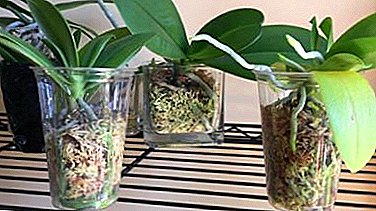 The plant itself should be prepared: get out of the old pot, put it along with the substrate (if it is stuck to the roots) in warm water. After some time, remove, wash off the remnants of the soil from the roots and leave to dry.
The plant itself should be prepared: get out of the old pot, put it along with the substrate (if it is stuck to the roots) in warm water. After some time, remove, wash off the remnants of the soil from the roots and leave to dry.- When the roots of the plant are completely dried, you can see, it is necessary to carefully examine them, to remove all the rotted areas with scissors.
- The bottom of the pot should be filled with approximately 5 cm of expanded clay, so that water can drain, and with a small layer of substrate. On the received "pillow" to put a plant, straighten the root system, put too long aerial roots in the pot, and fill up all free places with the substrate. It should be evenly distributed between the roots, occasionally slightly crushing, the growth point of the orchid should not be covered with bark.
- It is necessary to ensure that the plant in the new packaging is not hung out.
There are certain difficulties when watering orchids planted in a glass pot without drain holes. The flower should be watered superficially with a watering can or shower. For, to drain the excess water, the container is turned, holding the flower. For this purpose, some growers place moss on top of the substrate in order to avoid the loss of pieces of bark. In this way, watering is 2 times less than usual.
We offer for viewing a visual video of planting an orchid in a glass container:
Plastic
- Prepare everything you need for planting: pot, scissors, drainage, substrate, activated carbon, you can cinnamon.
- Flower in an old pot pre-water.
- Remove the plant from the tank. To avoid injury to the roots, the old container can be cut.
- Carefully look at the roots, cut off the rotten areas with scissors.
- It is necessary to remove all the dry parts at the root neck of the orchid, at the point of contact of the plant with the ground.
- Cut the cuts with crushed activated charcoal or cinnamon.
- At the bottom of the pot we place a drain, a little bark, a plant. The root neck should be in the center of the pot, and the roots around the container walls. Filling the pot with soil, you need to ensure that the pieces of bark evenly filled all the free space between the roots.
Important! The first watering of an orchid after transplantation needs to be done with boiled water on the fifth day, the second watering - after another 2 weeks, and feeding should begin only after a month.
Opaque
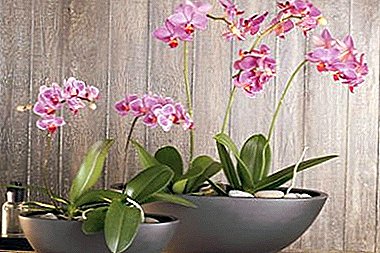 Prepare everything you need for planting, including the plant itself.
Prepare everything you need for planting, including the plant itself.- Carefully inspect the roots of an orchid, cut off all rotted or dried areas with scissors.
- Places pruning, according to experts, should be treated with activated charcoal or cinnamon.
- In the pot pour the drainage, a little substrate, place the plant itself in such a way that its roots are freely located around the walls of the pot. The resulting voids fill with soil
- Knock on the walls of the pot in order to settle the soil.
Next, a visual video about planting an orchid in an opaque pot:


 For what purpose the transparent walls of the pot are useful, so it is for tracking the condition of the roots of the orchid and the substrate. This allows you to regulate the watering of the plant, detect the diseases of the root system in time or detect pests.
For what purpose the transparent walls of the pot are useful, so it is for tracking the condition of the roots of the orchid and the substrate. This allows you to regulate the watering of the plant, detect the diseases of the root system in time or detect pests. The plant itself should be prepared: get out of the old pot, put it along with the substrate (if it is stuck to the roots) in warm water. After some time, remove, wash off the remnants of the soil from the roots and leave to dry.
The plant itself should be prepared: get out of the old pot, put it along with the substrate (if it is stuck to the roots) in warm water. After some time, remove, wash off the remnants of the soil from the roots and leave to dry. Prepare everything you need for planting, including the plant itself.
Prepare everything you need for planting, including the plant itself.